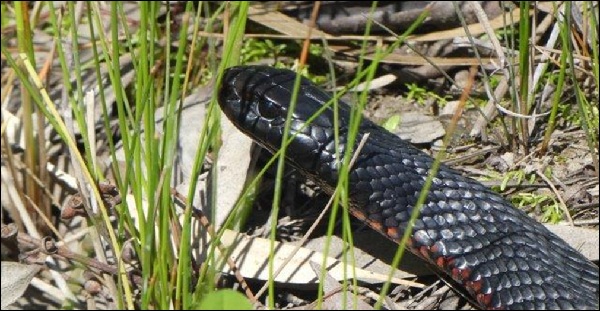
Red-bellied black snake, by Keith Ward, Goulburn Broken CMA
When you’re out and about this summer make sure you keep an eye out for our slithery friend: the venomous red-bellied black snake.
Red-bellied black snakes account for 16 percent of all snake bites - but don’t worry, these snakes try their best to avoid humans and no deaths have been recorded from their bites. Brown snakes bite more often (41%) and tiger snakes (17%) are similar to red-bellies.
This snake has a shiny black back and a red belly making them easy to distinguish when spotted. Don't attempt to capture or harm snakes. Instead call DELWP on 136 186 for further advice or call a licensed snake catcher.
Did you know that these scaly creatures often forage for food in water?
Red-bellied black snakes can submerge themselves completely when on the hunt for something to eat and sometimes stay under water for over 20 minutes!
Frogs and tadpoles are their favourite foods, but they will also eat fish, lizards, eggs, small mammals and other snakes, they sometimes even eat other red-bellies!
These snakes are most commonly found in south-east Queensland, eastern New South Wales and Northern Victoria. They seek out moist habitats in forest, woodlands and grasslands close to water – like the rivers, wetlands and floodplains that receive water for the environment. It is rare to find a red-bellied black snake more than 100 meters from a water source.
These striking snakes typically mate in spring, during October and November. Male snakes will fight each other to gain access to the female. When fighting they put on quite a display, they will spread their necks, and rear the top half of their bodies up twisting their necks around one another. They will hiss at each other and maybe even bite (luckily, they are immune to their own species venom) before one will accepted defeat and slowly slither away.
The winning male will mate with the female. Female red-bellied black snakes are ovoviviparous, meaning they do not lay eggs like many other snakes instead they give birth to live young. The female can give birth to as many as 40 baby snakes! When these little tackers are born, they already have well developed venom glands, making them just as toxic as their parents. Yikes! Life is hard for a little red-belled black snake, many are eaten by birds and other snakes before they can grow up.
How do environmental flows support red-bellied black snakes?
- Red-bellied black snakes like to reside near water so flows delivered to rivers, wetlands and floodplains provide some habitat, this is particularly important in dry landscapes where wetlands and floodplains have been disconnected from the main river channel.
- Frogs, tadpoles and fish are a key part of red-bellied black snake’s diet, without access to water bodies they would not be able to find these key resources.